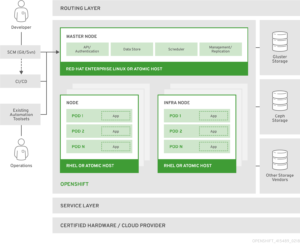In today’s fast-paced digital landscape, organizations are increasingly adopting containerization to streamline application development and deployment. One of the leading platforms in this space is the OpenShift Container Platform by Red Hat. This blog delves into the key features, benefits, and use cases of OpenShift, providing a comprehensive overview for developers and IT professionals.
What is OpenShift Container Platform?
The OpenShift Container Platform is a hybrid cloud application platform that enables organizations to build, deploy, and manage containerized applications at scale. It is built on top of Kubernetes, the popular open-source container orchestration engine, and leverages Red Hat Enterprise Linux (RHEL) for enhanced security and stability.
Architecture:

[Source: Documentation / OpenShift Container Platform 3.11 / Architecture / Overview / What Are the Layers?]
Red Hat OpenShift Container Platform
Install and run OpenShift on your own physical or virtual servers, either on-site or in the public cloud.
Red Hat OpenShift Dedicated
Using your own OpenShift cluster, which is run and maintained by Red Hat and hosted in the public cloud, create and administer containerized apps.
Red Hat OpenShift Online
Build, launch, and host apps in the Red Hat-managed and supported public cloud with speed. Check out the great features, register for free, and begin writing and using apps at openshift.com.
Benefits of using OpenShift Container platform:
- Advantages of OpenShift Security
- Speed application development and boost productivity
- Scalability and Availability
- Multi cloud and Hybrid cloud
- Developer Productivity
Advantages of OpenShift Security:
OpenShift’s enterprise-grade features are a major factor in corporate clients’ decision to use it other than Kubernetes, choosing OpenShift’s higher standards and demands for security and compliance.
In OpenShift, role-based access control (RBAC) is a mandatory feature unlike in a standard Kubernetes setup. This makes it possible for various engineering team roles to have permissions based on the concept of least privilege. For instance, although software engineers are limited to certain Kubernetes namespaces, Kubernetes administrators may have complete access to the cluster.
Pod Security restrictions (PSPs), which are extended to the Kubernetes Pod level, are derived from the built-in Security Context Constraint (SSC), which offers default execution restrictions such prohibiting containers from being executed with root capabilities. The security level of the entire Kubernetes cluster is significantly increased by these preset baseline settings that come with OpenShift.
The Red Hat Container Catalog, which is included with OpenShift, lets developers use container images that Red Hat and its partners have tested and approved. As opposed to obtaining container images straight from online sources, these images are tracked, updated, and routinely examined for flaws and vulnerabilities, improving the organization’s security posture.
Speed application development and boost productivity:
An effective software development pipeline is fueled by a strong continuous integration and delivery (CI/CD) procedure. OpenShift is crucial to the generation of business value because it provides developers with the tools they need to create, test, and launch their applications into production, effectively addressing the need to implement end-to-end CI/CD pipelines.
Tekton is the framework that makes it possible to create cloud-native CI/CD pipelines. Tekton defines and executes the required activities using Kubernetes’ control plane and Custom Resource Definitions (CRDs). Tekton allows software engineers to write code for their CI/CD pipelines. Tekton covers a variety of situations and is based on industry standards. Additionally, the pipelines developed can be used with other tools, such Jenkins or Knative, in addition to OpenShift, because Tekton is open source and adheres to common standards.
Red Hat provides OpenShift Pipelines, a CI/CD solution built on Tekton and native to Kubernetes, to streamline and simplify the pipeline construction process overall. In addition to offering a seamless experience and close connection with other OpenShift tools, this makes the pipeline safer and more resilient by allowing each stage to operate in an own container and scale on its own.
Scalability and Availability:
OpenShift offers robust scalability and high availability features. It can automatically scale applications based on demand, ensuring that resources are used efficiently. Additionally, it provides built-in support for load balancing and failover, ensuring that applications remain available even during peak times or in case of failures.
OpenShift Monitoring and Logging:
Any system that adheres to the most fundamental best practices should have the capability to track an application workload and gather the logs in one location. The implementation of these may differ depending on whether your application is running in an on-premises or cloud environment. OpenShift’s ability to be deployed across several environments presents a problem, but it is also one of its advantages. The ability to make your system applications portable between environments will be hampered if a developer must interface with a particular tooling in the environment where OpenShift is deployed, such as AWS CloudWatch or Azure Monitor.
OpenShift is pre-configured with logging and monitoring features to streamline the development process and standardize the deployment and operation of the applications. To be fair, OpenShift goes beyond those features and addresses a number of observability-related topics by utilizing well-known open-source projects: Istio to implement a service mesh for distributed microservices architectures, Jaeger for transaction tracing, Kali for dashboards and visualization, and Prometheus for monitoring and alert management.
Multi-cloud and Hybrid cloud:
OpenShift facilitates deployment in on-premises settings and across numerous cloud providers, allowing enterprises to implement a hybrid cloud approach. Because of this adaptability, companies can maximize performance and minimize expenses while avoiding vendor lock-in.
Customers of OpenShift have the option to install and run in AWS, Microsoft Azure, and Google in addition to an on-premises self-managed environment. This method makes it simpler to run a workload on a hybrid cloud architecture or move from on-premises to the public cloud.
Developer Productivity:
Developers can synchronize the development process by utilizing the ecosystem of tools that Kubernetes offers. A variety of projects are available to make the developer experience as seamless as possible, ranging from using Helm Charts to create the most complicated container-based application to administering Kubernetes clusters using CLI tools like kubectl.
OpenShift provides you with a fully functional Kubernetes cluster. Therefore, OpenShift is compatible with all Kubernetes-related tools. By offering supplementary CLI tools and a web-based user interface that grants control over all OpenShift platform capabilities, Red Hat further improved the developer experience.
Red Hat OpenShift Container Platform is a powerful solution for enterprises looking to leverage Kubernetes for their containerized applications. With its enhanced developer tools, robust scalability, high availability, and comprehensive security features, OpenShift provides a complete platform for managing containers in production environments. By adopting OpenShift, organizations can streamline their development and operations processes, ensuring efficient and reliable application delivery. Embrace the capabilities of Red Hat OpenShift Container Platform to take your container orchestration to the next level and achieve greater agility and efficiency in your IT operations.
 | Saikrishna Madupu, Sr. DevOps Engineer Sai is an IT professional with experience in DevOps Automation, Configuration Management tools, Container workloads and orchestration of those workloads via Kubernetes. A self-starter, and passionate problem-solver, with a flair for innovative design, with an ability to work towards automation whenever possible. He is an experienced Linux, Cloud data center operations and infrastructure engineer. He worked as a Devops cloud consultant in the past, helping clients in migrate on-prem applications to cloud, and holds certifications for AWS, Terraform, Gitlab, and other technologies. |

